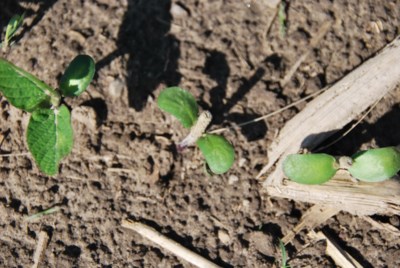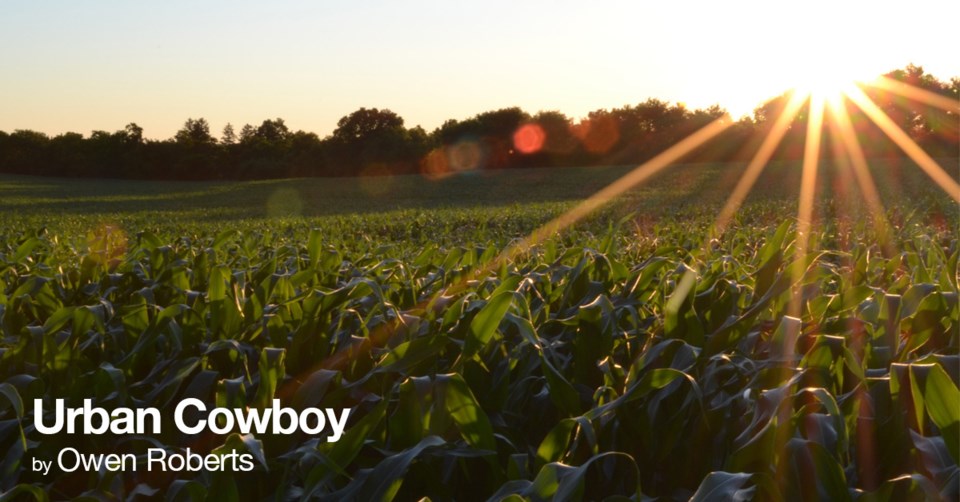Farmers drive hard toward May 10 — that’s the generally agreed-upon date that they must complete planting, or production suffers. The yield potential of crops is said to drop by one per cent per day for every day planting is delayed.
And that’s a huge figure, given the value of crop production to the province’s economy.
 Early emergence from a soybean. Photo courtesy of the Grain Farmers of Ontario.
Early emergence from a soybean. Photo courtesy of the Grain Farmers of Ontario.Consider soybeans, Ontario farmers’ biggest field crop. Last week, Soy Canada, the national advocacy group for this crop, released a first-of-its-kind report quantifying the economic impact of soybeans to Canada’s economy. It comes in at a staggering $5.6 billion.
As well, the report noted, the sector is responsible for 54,000 jobs. Most of the activity is in Ontario, which at 2.6 million acres, produces the lion’s share of soybeans in Canada.
Add in another 2.21 million acres of corn — and all the other crops grown in the province, not to mention livestock — and that figure skyrockets.
A big reason soybeans have done so well in Ontario in the past 25 or so years is because of the commitment to research by the federal and provincial governments, by universities, by farmers, by seed companies, and by researchers themselves. Governments supported scientists at research institutions such as the University of Guelph, in response to requests from the agricultural sector to develop high-yielding soybeans that could handle cooler temperatures. That was a game-changing effort, and it gave farmers an opportunity to compete in new, profitable markets.
Ottawa offered up its nationwide look at the agri-food sector last week too, with its annual report, Overview of the Canadian Agriculture and Agri-Food System. The report, which provides 2013-14 data, notes that agriculture and agri-food provides one in eight jobs in Canada, employing more than 2.3 million people. Canada’s is the world’s fifth-largest exporter of agriculture and food products, and that export sales grew 12 per cent.
The federal agriculture and agri-food minister, Lawrence MacAulay, is onside with support for farming.
“Canadian farmers can look forward to a promising future,” he says. “Through its continued support and investment in research and innovation, the Government of Canada is working to ensure our agriculture and agri-food sector remains strong, while adapting to changing consumer demands, advances in technology and increasing globalization.”
The University of Guelph is doing its part to support the agri-food system and look into the future with a new initiative called Food From Thought.
In January, the University was among 30 post-secondary institutions across Canada selected to participate in what’s called the Canada First Research Excellence Fund competition. This fund helps competitively selected Canadian post-secondary institutions turn their key strengths into world-leading capabilities.
Guelph is the only institution in the country whose submission was based on agriculture and food. Food From Thought supports the submission by bringing forward the university’s expertise in what’s become known as “precision” agriculture.
 Researcher launches a drone.
Researcher launches a drone.Precision agriculture is a broad but descriptive term. In part, it involves the precise use of inputs such as fertilizer and pesticides, guided by using site-specific data gathered through advanced technology such as drones and satellite mapping. This data helps farmers determine the exact location and amount of inputs required, reducing waste and exposure and lessening their environmental impact.
On the livestock side, an example of precision agriculture is the identification and development of lines of livestock with naturally high immune response to disease, animals that are healthier, are more productive and require less veterinary attention. Another example is robotic milking systems for dairy cows, which are sensitive to cow health, milk production, and changes in diet and weight.
Other techniques that are part of precision agriculture include DNA barcoding. It’s a revolutionary technology in which the University of Guelph has been a world leader. Among other things, it offers a way to rapidly identify invasive species that could devastate the agricultural sector.
Precision agriculture is key to feeding our growing population. It helps farmers be productive and as environmentally and economically sustainable as possible, while ensuring the food supply is safe and wholesome.
Some aspects of precision agriculture, and much more, will be presented in a snappy, high-energy “Ted Talks” format on June 2 in War Memorial Hall at the University of Guelph, when eight agri-food researchers present Guelph Talks – Food. This event is being presented by the University of Guelph Food Institute in conjunction with annual Canadian Science Writers’ Conference, coming to the University of Guelph for the first time June 2-5. The food institute describes Guelph Talks – Food as “an engaging event designed to share some of the University of Guelph’s most cutting-edge research advancing healthy, productive, and competitive Canadian agriculture and food systems.”
To me, what’s fascinating is that many of these new approaches to food production – which were only a vision not long ago -- are already a reality. Food From Thought aims to advance them further into the mainstream…into the same fields and barns we drive by now, marveling at how so few people are creatively feeding so many, and getting a glimpse of how they’ll do it in the years to come.
